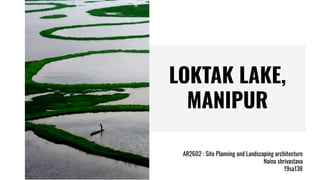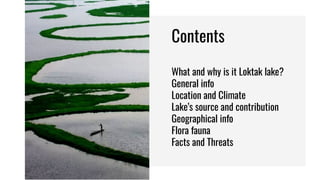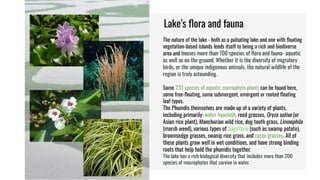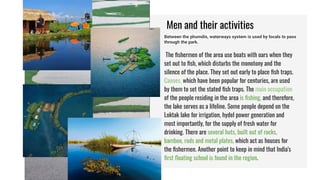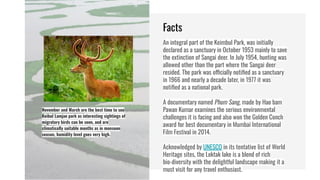Case study of landscape of Loktak Lake in Manipur .pdf
- 1. LOKTAK LAKE, MANIPUR AR2602 : Site Planning and Landscaping architecture Naina shrivastava 19sa138
- 2. Contents What and why is it Loktak lake? General info Location and Climate Lake’s source and contribution Geographical info Flora fauna Facts and Threats
- 3. The lake is located at Moirang in Manipur state, India. The etymology of Loktak is Lok = "stream" and tak = "the end".It is famous for the phumdis (heterogeneous mass of vegetation, soil and organic matter at various stages of decomposition) floating over it. Loktak Lake is the largest natural freshwater lake and ancient supervolcanic caldera in India. The lake has a surface area of around 287 square kilometers. Loktak is also considered a pulsating lake, meaning the water levels vary significantly (from roughly 287 sq.kms to 500 sq kilometers) with the seasonal rains. What is Loktak Lake and Why is it called Loktak?
- 4. An oxbow lake forms when a river creates a meander, due to the river's eroding the bank. After a long period of time, the meander becomes very curved, and eventually, the neck of the meander becomes narrower and the river cuts through the neck during a flood, cutting off the meander and forming an oxbow lake. Example - Loktak Lake 1998 loktak lake March 19, 2018
- 5. caldera A caldera is a large depression formed when a volcano erupts and collapses. During a volcanic eruption, magma present in the magma chamber underneath the volcano is expelled, often forcefully.Some calderas form a lake as the bowl-shaped depression fills with water.
- 6. Known for its floating circular swamps, which are called phumdis in the local tongue. These swamps look almost like islands and are a mass of soil, organic matter and vegetation. The phumdis float around on the lake’s surface due to decay from the bottom. Some are so large that the indigenous fishing folk Meiteis have constructed makeshift floating huts locally known as phumsangs on them. The lake houses the only floating national park in the world, the Keibul Lamjao National Park, which is the last refuge of the endangered brow-antlered deer or sangai, Manipur's state animal. It is a natural formation without human aid and thus famous in the entire world. In addition, the lake shelters about 230 species of aquatic plants, 100 types of birds and 400 species of fauna like barking deer, sambar and Indian python and is a visual treat for birdwatchers.
- 7. Loktak Lake is fed by the Manipur river and several tributaries and 'Ungamel Channel' (Ithai Barrage) is its only outlet now. -The Manipur River rises from Karong and flows through south of Imphal and gives birth to this floating lake which provides sustenance and livelihood to many people. For the past many years, this lake has been a source of food, freshwater, carrying occupation, hydropower generation, and carries sustenance. Most of the fishermen depend upon this lake for their livelihood. The most important plants used to be tou, singut, and khoimom. Also, a dam was built on the lake in the 1980s, and today it supplies hydropower to different states of India.This lake has been serving around 55 villages for the past many years for vegetation, freshwater, irrigation, domestic water use, and agricultural purposes. Lake’s source and contribution
- 8. Loktak Lake forms the direct catchment area of 980 sq. km from which 430 sq. km is for paddy cultivation, and 150 sq. km is covered under habitation. The remaining 400 sq. km is the forest area. At the South of Imphal valley, this lake forms marshy land and has large pockets of freshwater. There are two main zones of the lake, which are known as “Buffer Zone” and “Core Zone.” Buffer Zone is also known as the balance area, and Core Zone is known for the protected area. At the South of this lake, there are some islands formed names as Sendra, Lthing, and Thanga islands. Geographical info
- 9. The nature of the lake - both as a pulsating lake and one with floating vegetation-based islands lends itself to being a rich and biodiverse area and houses more than 700 species of flora and fauna- aquatic as well as on the ground. Whether it is the diversity of migratory birds, or the unique indigenous animals, the natural wildlife of the region is truly astounding. Some 233 species of aquatic macrophyte plants can be found here, some free-floating, some submergent, emergent or rooted floating leaf types. The Phumdis themselves are made up of a variety of plants, including primarily: water hyacinth, reed grasses, Oryza sativa (or Asian rice plant), Manchurian wild rice, dog tooth grass, Limnophila (marsh weed), various types of Sagittaria (such as swamp potato), broomsedge grasses, swamp rice grass, and carex grasses. All of these plants grow well in wet conditions, and have strong binding roots that help hold the phumdis together. The lake has a rich biological diversity that includes more than 200 species of macrophytes that survive in water. Lake’s flora and fauna
- 10. 57 species of waterbirds and another 14 species of wetland associated birds have been noted in the lake including 28 species of migratory waterfowl (most migrating from different parts of the northern hemisphere beyond the Himalayas).Also recorded were 425 species of animals—249 vertebrates and 176 invertebrates). Out of the 101 species of birds that are found in Loktak, three are globally threatened. Some of the rare birds found are the Common Pochard (vulnerable), Ferruginous Duck (near threatened), Japanese quail (near threatened), and Manipur Bush Quail (endangered). Lake’s fauna
- 11. Also found, are the Northern Pintail, Gadwall, Greylag Goose, Red Collared Dove, Sarus Crane, Great White Pelican, Black Kite, Pied Kingfisher and the Oriental Skylark. Some of the gorgeous fauna inhabiting the region includes the Indian python, sambar, barking deer, rhesus monkey, hoolock gibbon, Indian civet, and Temminck’s golden cat. An approximate of 1,500 tonnes of fish is sourced from the Lake per year. Old varieties of local fishes like ngamu, ukabi, ngaril, pangba, tharak, and ngashap which were near decline have also been reintroduced into the system. Lake’s fauna
- 12. The fishermen of the area use boats with oars when they set out to fish, which disturbs the monotony and the silence of the place. They set out early to place fish traps. Canoes, which have been popular for centuries, are used by them to set the stated fish traps. The main occupation of the people residing in the area is fishing, and therefore, the lake serves as a lifeline. Some people depend on the Loktak lake for irrigation, hydel power generation and most importantly, for the supply of fresh water for drinking. There are several huts, built out of rocks, bamboo, rods and metal plates, which act as houses for the fishermen. Another point to keep in mind that India’s first floating school is found in the region. Men and their activities Between the phumdis, waterways system is used by locals to pass through the park.
- 13. What is Loktak Lake issue? The Loktak Lake and its precincts have faced serious problems. The distress situation in the lake is due to shifting agriculture, extensive deforestation, and unscientific land use practices in the catchment areas which bring a large amount of silt to the lake. To address all the issues raised on the health of the lake, Government of Manipur has set up the Loktak Development Authority with the objective to enable administration, control, protection, improvement, conservation and development of the natural environment of the lake and for matter concerned thereto.
- 14. An integral part of the Keimbul Park, was initially declared as a sanctuary in October 1953 mainly to save the extinction of Sangai deer. In July 1954, hunting was allowed other than the part where the Sangai deer resided. The park was officially notified as a sanctuary in 1966 and nearly a decade later, in 1977 it was notified as a national park. A documentary named Phum Sang, made by Hao bam Pawan Kumar examines the serious environmental challenges it is facing and also won the Golden Conch award for best documentary in Mumbai International Film Festival in 2014. Acknowledged by UNESCO in its tentative list of World Heritage sites, the Loktak lake is a blend of rich bio-diversity with the delightful landscape making it a must visit for any travel enthusiast. Facts November and March are the best time to see Keibul Lamjao park as interesting sightings of migratory birds can be seen, and are climatically suitable months as in monsoon season, humidity level goes very high.
